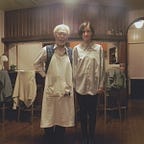Another day I showed my ABC book to my friend Nia. She pointed to another aspect of the book–the one that has to do with colours, shapes and how paired with the text they form a new meaning.
I didn’t record her ruminations so I asked her afterwards to write down what she told me that day. She did–and it is beautiful, insightful and meaningful.
“As I have already said, I admire your work on this one for multiple reasons.
The biggest one is, of course, the contrast between form and content. When you look through the book, the effect goes on you slowly: first things appealing are usually the vivid and spring-ish colours, very much appropriate and canonical for the ABC book; second thing is the softness of shape; it seems like you rarely have any sharp angles or lines. Everything seems soft and round. Nothing expresses danger by the way it is presented.
I think that this contrast plays a big role in how successful your work appears to me. Because inevitably the one who views it is being introduced to what is the real content of your book; with some pictures being straight-up disturbing by content, not by form because it is still done in a very lovely manner. And the fleeting soft and bright watercolours look like they are mocking us*. I already used this word, such in a peaceful and, it seems, close to the natural state we find the objects presented.
Some pictures do express some hope though, but I am not sure about the whole book — probably, each of us who has looked at it has their own impression about it, which is natural.
As I looked through it several times more I see one more contrast that you seem to be fond of — the one between what is the opposite of nature (the whole thing about military scenes and power station scenes) and nature that is overpowering it once the humans have abandoned it. Maybe this is the source of gentleness that can really be felt through each illustration.
Like you know, no matter what we do, nature never seems to hold a grudge, but for how long is it going to be like this — Although we will probably manage to exterminate ourselves faster than its mercy ends.
And I love how you have incorporated Mark Twain in here, because I am not sure if you are aware of this or not, but he is a delayed damage weapon. Many people having read “Huckleberry Finn” or “Tom Sawyer” think of him as a writer for children, but they are not aware of so many sharp satirical essays written by him that provide a wide and smart critique on religion, society and politics.
Maybe you know that but if not, I really recommend to see into the works that you have quoted, even if you don’t find them agreeable, they are really sharp and charismatic.
What I wanted to say with his example is that sometimes we imagine we know or understand something, but in reality what we choose to know is just a peak of an iceberg. So in fact we really have to relearn so many things from the ABC, which are lessons on how to be human, and how to live with others, and what is our lives. In fact, learning the alphabet is a great deal of work that has to be performed by every child and once you are over that a whole new world opens to you. In the same manner there should be some ABC for older people, because there is a tendency of grown-ups to disregard the basics thinking they (the adults) are too advanced beings to do such things.
Even if you did not really mean to say this with your book, these are thoughts that are being born by it, at least in me”
By Moineau Neeah
* From our live conversation I remember she told me that with such bright and vibrant colours one would expects to see depicted a cute animal or a blameless object, but what we see depicted instead is lethal machinery.
